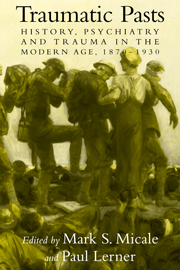Book contents
- Frontmatter
- Contents
- Contributors
- Preface
- 1 Trauma, Psychiatry, and History: A Conceptual and Historiographical Introduction
- Part One Travel and Trauma in the Victorian Era
- Part Two Work, Accidents, and Trauma in the Early Welfare State
- Part Three Theorizing Trauma: Psychiatry and Modernity at the Turn of the Century
- 6 Jean-Martin Charcot and les névroses traumatiques: From Medicine to Culture in French Trauma Theory of the Late Nineteenth Century
- 7 From Traumatic Neurosis to Male Hysteria: The Decline and Fall of Hermann Oppenheim, 1889–1919
- 8 The Construction of Female Sexual Trauma in Turn-of-the-Century American Mental Medicine
- Part Four Shock, Trauma, and Psychiatry in the First World War
- Index
- Titles in the series
8 - The Construction of Female Sexual Trauma in Turn-of-the-Century American Mental Medicine
Published online by Cambridge University Press: 14 October 2009
- Frontmatter
- Contents
- Contributors
- Preface
- 1 Trauma, Psychiatry, and History: A Conceptual and Historiographical Introduction
- Part One Travel and Trauma in the Victorian Era
- Part Two Work, Accidents, and Trauma in the Early Welfare State
- Part Three Theorizing Trauma: Psychiatry and Modernity at the Turn of the Century
- 6 Jean-Martin Charcot and les névroses traumatiques: From Medicine to Culture in French Trauma Theory of the Late Nineteenth Century
- 7 From Traumatic Neurosis to Male Hysteria: The Decline and Fall of Hermann Oppenheim, 1889–1919
- 8 The Construction of Female Sexual Trauma in Turn-of-the-Century American Mental Medicine
- Part Four Shock, Trauma, and Psychiatry in the First World War
- Index
- Titles in the series
Summary
Late in the spring of 1871, a thirty-year-old seamstress was admitted to an eminent New York asylum in what her physicians termed an “acutely maniacal condition.” She had suffered terribly during the weeks prior to her commitment – emotionally erratic, unable to eat or sleep properly, she had grown increasingly weak and disconsolate. Moreover, her caretakers reported that she “was destructive of clothing, pulled her hair out, was noisy, incoherent, and violent; opposed care, wandered about, and was with difficulty controlled.” Having exhibited a certain nervous debility throughout her adult life, the young woman's affliction was, if not entirely explicable, at least familiar in its basic contours. Or so it seemed. On further examination, the asylum physicians discovered scarring and discoloration that extended over much of her body, the result, they soon learned, of habitual injections of morphine. Consistent with established practices, her doctors prescribed a daily dose of chloral to allay her addiction and placed her on an exacting program of bedrest and overfeeding devised to hasten her recovery.
Observing this regimen, the woman grew stronger and seemingly more contented in the weeks and months that followed. By August, her menstrual cycle had resumed after a lengthy cessation, a sure sign of health from her physicians' point of view. Accompanying her period, however, was a swelling of the right breast so severe that adhesive straps were required to provide support and elevation.
- Type
- Chapter
- Information
- Traumatic PastsHistory, Psychiatry, and Trauma in the Modern Age, 1870–1930, pp. 172 - 202Publisher: Cambridge University PressPrint publication year: 2001
- 5
- Cited by

